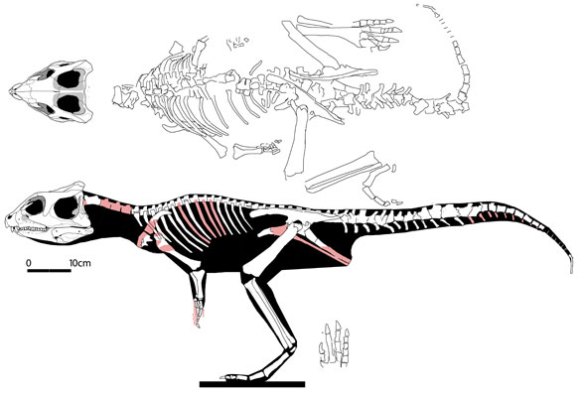Updated April 22, 2014 as poposaurs now nest as basal archosaurs.
Which dinosaur represents the most basal ornithischian?
As others before him, Marc Spencer (2007) recovered Pisanosaurus as the most basal ornithischian in his online Masters thesis. A monophyletic Genasauria was recovered with two major clades: Eocursor+ Cerapoda and Fabrosauridae + Thyreophora. Lesothosaurus was recovered within the Fabrosauridae, along with a clade consisting of Stormbergia+ Agilisaurus. The Heterodontosauridae was recovered as the basalmost taxon of the Cerapoda.
Nesbitt (2011) remarked, “Pisanosaurus is almost always found as the basalmost member of Ornithischia (Langer and Benton, 2006; Butleret al., 2007, 2008b; Irmis et al., 2007a) because of the combination of ornithischian synapomorphies and archosaur plesiomorphies, such as the anteroventrally directed pubis…Most recently, Heterodontosaurus was found as a basal ornithischian near Pisanosaurus (Butler et al., 2008b). This position better reflects the fossil record of Ornithischia and suggests that some of the ‘‘odd’’ features (e.g., the hand) of Heterodontosaurus present in non-ornithischian dinosaurs (e.g., Herrerasaurus) may represent plesiomorphies of Dinosauria rather than autapomorphies of Heterodontosaurus.”
Nesbitt’s (2011) tree was not able to resolve basal Ornithischia. Saturnalia, Lewisuchus and Marasuchus nested as outgroup sisters. Scelidosaurus, Daemonosaurus and Massospondylus kaalae were not included.

Figure 1. Daemonosaurus and kin. Derived from a sister to the basal theropod, Herrerasaurus, Daemonosaurus, Pisanosaurus and Massospondylus are close sister taxa (within 1 step of each other). Daemonosaurus now nests at the base of the Ornithischia. Scelidosaurus and Heterodontosaurus are its closest sisters within that clade. BTW, I’m curious about Scelidosaurus. A tracing of a photograph produced a mandible with a convex ventral margin of the mandible, but old drawings do not. Which is valid?
More Taxa = Greater Resolution
Here, in the large reptile study, Daemonosaurus and Pisanosaurus nest at the base of the Ornithischia. Earlier the tree nested poposaurs with phytodinosaurs, but as of April 22, 2014, poposaurs nest as basal archosaurs.
What About Scutellosaurus?
According to the large tree the smaller and more lightly armored Scuttelosaurus (Colbert 1981) and unarmored Lesothosaurus nest higher in the ornithischian clade. So a serial and phylogenetic size reduction seems to have occurred in this clade. Eocursor and Lesothosaurus were similar to one another and lacked armor.

Figure 3. Yinlong overall. This basal ceratopsian had a larger skull, shorter neck and shorter tail than Hexinlusaurus, its phylogenetic predecessor.
And Yinlong?
Among the basal ceratopids is Yinlong (Xu et al. 2006, Fig. 3), a Late Jurassic survivor of an earlier radiation. It retained premaxillary fangs and was primarily bipedal.
Other Saber-Toothed Ornithischians
I refer the reader to this website by Jaime Headden for more saber (or sabre)-toothed basal ornithischians. There were several that I’d like to learn more about.
The Antiquity of Scelidosaurus
Scelidosaurus lived during the Late Sinemurian, within 5 million years of the Latest Triassic. The much smaller Scuttelosaurus (Fig. 2) was a contemporary. Thulborn (1977) classified Scelidosaurus within the Ornithopoda, but recent workers ally Scelidosaurus with ankylosaurs and stegosaurs. Scelidosaurus retained elongated maxilla teeth, a vestigial pedal digit 5, lacked much of a prepubic process on the pubis and had a relatively small postnarial process of the premaxilla, all traits shared with more primitive taxa.
References
Colbert EH 1981. A primitive ornithischian dinosaur from the Kayenta Formation of Arizona. Bulletin of the Museum of Northern Arizona 53:1-61.
Crompton AW and Charig AJ 1962. A new ornithischian from the Upper Triassic of South Africa. Nature 196:1074-1077
Nesbitt SJ 2011. The early evolution of archosaurs: relationships and the origin of major clades. Bulletin of the American Museum of Natural History 352: 292 pp.
Norman D 2001. Scelidosaurus, the earliest complete dinosaur in The Armored Dinosaurs, pp 3-24. Bloomington: Indiana University Press.
Spencer MR 2007. A Phylogenetic Analysis of the Basal Ornithischia (Reptilia, Dinosauria). Online Thesis.
Sues H-D, Nesbitt SJ, Berman DS and Henrici AC 2011. A late-surviving basal theropod dinosaur from the latest Triassic of North America. Proceedings of the Royal Society B, published online
Thulborn, RA 1977. Relationships of the lower Jurassic dinosaur Scelidosaurus harrisonii. Journal of Paleontology. 51: 725-739
Xu X, Forster CA, Clark J M and Mo J 2006. A basal ceratopsian with transitional features from the Late Jurassic of northwestern China. Proceedings of the Royal Society B: Biological Sciences. First Cite Early Online Publishing. online pdf
wiki/Daemonosaurus
wiki/Heterodontosaurus
wiki/Scelidosaurus
wiki/Scutellosaurus
wiki/Yinlong


That is actually Marc Spencer’s MS thesis, not his PhD thesis which is currently still on-going under the direction of Chris Brochu at the University of Iowa.
Why do you single out Massospondylus kaalae of all the massospondylids? Do you consider it more ornithischian-like than M. carinatus, Leyesaurus, Adeopapposaurus, etc.?
Principally the short skull and long premaxillary teeth. If you find a better specimen, let me know.